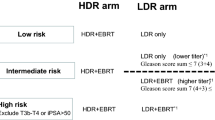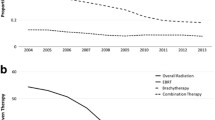Abstract
Background
Brachytherapy (BT) is a widely used treatment modality for elderly patients with localized prostate cancer (PCa).
Objective
To describe the patterns of BT use in octo- and nonagenarians treated for localized PCa in the USA. We hypothesized that most individuals treated with BT should remain alive for at least 10 years. We also postulated that BT should ideally be administered as monotherapy.
Patients and methods
Using the Surveillance Epidemiology and End Results (SEER)-Medicare-linked database, 2701 octo- and nonagenarians treated with BT between 1992 and 2009 were identified. Cumulative incidence rates and smoothed cumulative incidence plots were used.
Results
In patients with low-risk characteristics, 40 % received BT alone; 27 % received BT combined with ADT; 19 % received BT and EBRT; and 14 % received BT combined with both ADT and EBRT. Of intermediate-to-high-risk patients, 19 % received BT alone; 16 % received BT combined with ADT; 19 % received BT combined with EBRT; and 45 % received BT together with ADT and EBRT. Overall survival rate was 79 and 47 % at 5 and 10 years.
Conclusions
Less than half of elderly treated with BT remain alive at 10 years of follow-up. Moreover, the vast majority of those individuals not only receives BT, but is also exposed to two or even three combined therapy modalities. These findings are worrisome.



Similar content being viewed by others
References
Siegel R et al (2014) Cancer statistics, 2014. CA Cancer J Clin 64(1):9–29
Jarosek SL et al (2015) Propensity-weighted long-term risk of urinary adverse events after prostate cancer surgery, radiation, or both. Eur Urol 67(2):273–280
Warren JL et al (2002) Overview of the SEER-Medicare data: content, research applications, and generalizability to the United States elderly population. Med Care 40(8Suppl):IV-3–IV-18
Penson DF et al (2001) Determining cause of death in prostate cancer: are death certificates valid? J Natl Cancer Inst 93(23):1822–1823
Albertsen PC, Walters S, Hanley JA (2000) A comparison of cause of death determination in men previously diagnosed with prostate cancer who died in 1985 or 1995. J Urol 163(2):519–523
Klabunde CN et al (2000) Development of a comorbidity index using physician claims data. J Clin Epidemiol 53(12):1258–1267
Sun M et al (2011) Racial disparities and socioeconomic status in men diagnosed with testicular germ cell tumors: a survival analysis. Cancer 117(18):4277–4285
Droz JP et al (2014) Management of prostate cancer in older patients: updated recommendations of a working group of the International Society of Geriatric Oncology. Lancet Oncol 15(9):e404–e414
Austenfeld MS, Thompson IM Jr, Middleton RG (1994) Meta-analysis of the literature: guideline development for prostate cancer treatment. American Urological Association Prostate Cancer Guideline Panel. J Urol 152(5 Pt 2):1866–1869
Thompson I et al (2007) Guideline for the management of clinically localized prostate cancer: 2007 update. J Urol 177(6):2106–2131
Acknowledgments
This research received no specific grant from any funding agency in the public, commercial, or not-for-profit sectors.
Conflict of interest
The authors declare no conflicts of interest in preparing this article.
Ethical standard
This manuscript found approval by SEER-Medicare. The study has been performed in accordance with the ethical standards laid down in the 1964 Declaration of Helsinki and its later amendments.
Author information
Authors and Affiliations
Corresponding author
Additional information
Roger Valdivieso and Katharina Boehm have contributed equally.
Electronic supplementary material
Below is the link to the electronic supplementary material.
Rights and permissions
About this article
Cite this article
Valdivieso, R., Boehm, K., Meskawi, M. et al. Patterns of use and patient characteristics: brachytherapy for localized prostate cancer in octo- and nonagenarians. World J Urol 33, 1985–1991 (2015). https://doi.org/10.1007/s00345-015-1553-0
Received:
Accepted:
Published:
Issue Date:
DOI: https://doi.org/10.1007/s00345-015-1553-0




